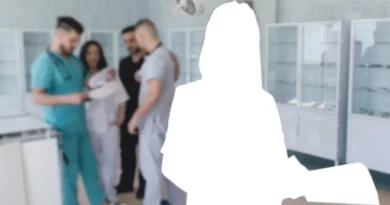Taking Aim – Medical Community Targets Scourge of Gun Violence
Dr. Ronald Gross doesn’t need to hear any more news reports to convince him that gun violence is a public-health crisis. In fact, he says, people who disagree have to come up with some rather convoluted reasons why.
“What people forget is, we lose about 38,000 lives each year in automobile crashes. We lose about the same number to gun violence every year. But people say, ‘guns are not a disease,’” said Gross, chief of Trauma, Acute Care Surgery, and Surgical Critical Care at Baystate Medical Center (See related Editorial, Page 6). “Yet, the CDC has done research into automobile injuries and deaths. Why? A car isn’t a disease, right? But based on those studies, we’ve made phenomenal advances in safety of the vehicles we drive. Why not do the same for guns?”
That’s an argument the Centers for Disease Control and Prevention and other medical organizations have been making since 1996, when federal lawmakers cut off funding for gun-violence research at the CDC, agreeing with the National Rifle Assoc. (NRA) and other pro-gun lobbyists that guns should not be classified as a public-health issue.
As high-profile shootings continue to dominate news cycles, however — including the worst-ever such event in U.S. history at an Orlando nightclub in June, and the killing of five police officers in Dallas earlier this month — calls to reverse that decision are on the rise.
“With approximately 30,000 men, women, and children dying each year at the barrel of a gun in elementary schools, movie theaters, workplaces, houses of worship, and on live television, the United States faces a public health crisis of gun violence,” Dr. Steven Stack, immediate past president of the American Medical Assoc. (AMA), said in the wake of the Orlando tragedy.
“Even as America faces a crisis unrivaled in any other developed country, the Congress prohibits the CDC from conducting the very research that would help us understand the problems associated with gun violence and determine how to reduce the high rate of firearm-related deaths and injuries,” he added. “An epidemiological analysis of gun violence is vital so physicians and other health providers, law enforcement, and society at large may be able to prevent injury, death, and other harms to society resulting from firearms.”
The American Academy of Pediatrics (AAP) went even further, planning to address both gun violence and the prejudices that drive some of it by convening pediatric experts in the coming weeks to identify new approaches to protect children and families from the epidemic of violence. The initiative will address gun violence as well as the underlying contributors of racism, religious intolerance, homophobia, xenophobia, terrorism, and other forms of intolerance.
“This week, a 4-year-old girl sat in the back seat of a car as her mother’s fiancé was shot to death,” said AAP President Dr. Benard Dreyer. “Standing next to his mother at a press conference, a 15-year-old boy wept openly for his father, who was shot and killed while selling CDs. Five police officers protecting and supporting peaceful protestors were targeted and killed, and others were wounded. Today, it is not enough to issue another press statement expressing outrage and sadness, urging our national leaders to fix the broken systems that are failing our children and their families.”
No matter what their stance on gun ownership, Gross said, Americans are clamoring for answers, and recognizing gun violence as a public-health crisis, and restarting the CDC research into its causes and effects on communities, would be a good start.
“The CDC has been prevented for over 20 years from doing any violence research as it relates to guns because the NRA has convinced elected officials that guns are not a disease, so the CDC has no right to investigate deaths caused by guns,” he told HCN. “But studying deaths and injuries, how to track them, who dies, why do they die — this is all stuff that makes perfect sense to those in the medical community, even to those of us in the medical community as rabid in defense of the Second Amendment as someone in the NRA.”
Trigger Warnings
The AMA’s stance is not a new one, but simply reiterates its long-standing policies supporting firearm safety and reducing and preventing gun violence. Its post-Orlando statement “recognizes that uncontrolled ownership and use of firearms, especially handguns, is a serious threat to the public’s health inasmuch as the weapons are one of the main causes of intentional and unintentional injuries and deaths,” and supports legislation calling for a waiting period before purchasing any form of firearm in the U.S., as well as requiring background checks for all handgun purchasers, and mandated penalties for crimes committed with the use of a firearm, including the illegal possession of a firearm.
While the AMA made some noise with that statement, Gross noted that the American College of Surgeons (ACS) issued its own call to action in January 2014, a month after the Sandy Hook tragedy. “Because violence inflicted by guns continues to be a daily event in the United States and mass casualties involving firearms threaten the health and safety of the public,” the organization noted, it outlined the following strategy:
• Legislation banning civilian access to assault weapons, large ammunition clips, and munitions designed for military and law-enforcement agencies;
• Enhancing mandatory background checks for the purchase of firearms to include gun shows and auctions;
• Ensuring that healthcare professionals can fulfill their role in preventing firearm injuries by health screening, patient counseling, and referral to mental-health services for those with behavioral medical conditions;
• Developing and promoting proactive programs directed at improving safe gun storage and the teaching of non-violent conflict resolution for a culture that often glorifies guns and violence in media and gaming; and
• Evidence-based research on firearm injury and the creation of a national firearm-injury database to inform federal health policy.
Gross — a gun owner himself — said the logic of all these points is “plain as the nose on my face,” but at the time, they offended many Americans, including many ACS members. He lamented the fact that any talk at all about curbs on who can own guns and how gun ownership is regulated tends to get the NRA crowd issuing warnings about the government wanting to take away gun rights from law-abiding citizens.
But that’s no reason, he said, to abandon the principle of “freedom with responsibility.” For example, he said, why not have a discussion about whether anyone except police and Armed Forces members should be able to possess the kind of weapons used in warfare? And what’s wrong with pushing for more education around safe ownership, storage, and use of guns in the home?
It shouldn’t be difficult, he went on, to establish and enforce laws about who should not own guns — convicted felons, people with certain mental-illness diagnoses, and people with terrorist connections come to mind — but the pro- and anti-gun sides have become so polarized over the years that they simply won’t hear the other side, even if compromise makes sense.
“There are those who should be allowed to own a gun no more than a guy convicted of vehicular homicide twice while driving drunk should have a driver’s license,” he said.
Meanwhile, as advocates and politicians debate those issues, American cities, including Springfield, bear the psychological impact of gun violence close to home.
Communities may feel overwhelmed by issues like violence and prejudice, said Dr. William Davila, vice president of Clinical Services for the Center for Human Development, and sometimes the only thing individuals can do is modify their own response to the anger and frustration they feel.
“People may feel disempowered, feel threatened by a loss of control, sensing threats to people who look like them, who live in their communities. Obviously there’s a level of frustration, and people deal with that in different ways,” Davila said.
When processing these issues, he noted, there’s a big difference between reacting and responding.
“Reacting is something that’s emotional; it’s about you as an individual,” he explained. “It’s often impulsive, and it’s a tactical response. I like to draw a contrast between a tactical response and a strategic response, which is more about long-term thinking. Reacting is working off someone else’s agenda. You’re not thinking about effectiveness or sustainability or long-term results, just the immediate moment. That may be cathartic, and you may have some release in the moment, but it’s not therapeutic; it’s not productive.”
Responding, on the other hand, involves being more thoughtful and engaging with other people. “It’s not just about you anymore. It’s thinking strategically about some long-term solutions to this problem. It doesn’t mean your response can’t be legitimately founded in anger, but there has to be some thoughtfulness. It’s a response that allows you to set your own agenda.”
Enough individuals in a community that feels marginalized that responds this way, instead of knee-jerk reacting, can lead to systemic change, Davila went on. “Not all anger is bad; we just want people to use it as a catalyst for constructive dialogue, and for change.”
Targeting Youth
Some strategic efforts to curb gun violence are already in effect in Massachusetts. For example, the Safe and Successful Youth Initiative (SSYI), launched in 2011, serves 11 Massachusetts cities, including Springfield and Holyoke. Implemented in partnership with the state Executive Office of Public Safety, it provides funding to cities to implement a coordinated intervention strategy in partnership with community-based organizations, education and training efforts, and workforce-development programs, and also includes street outreach, trauma counseling, and case-management support.
Its reason for existing was obvious; according to the Mass. Public Health Council, Massachusetts was the most violent state in the Northeast between 2001 and 2010, with 1,667 homicide victims, nearly 40{06cf2b9696b159f874511d23dbc893eb1ac83014175ed30550cfff22781411e5} of them between ages 14 and 24. Besides the human toll, the organization noted, youth violence impacts communities in terms of economic development, healthcare costs, and lowered property values.
In December 2014, then-Gov. Deval Patrick released an evaluation of SSYI, illustrating positive benefits to the youth involved in the program. It showed that youth who were not involved in SSYI, but had similar violent crime backgrounds, were 42{06cf2b9696b159f874511d23dbc893eb1ac83014175ed30550cfff22781411e5} more likely to be incarcerated than youth who were actively engaged in SSYI services. From a fiscal perspective, every dollar spent on SSYI in Springfield recouped $6.95 in benefits from preventing victimizations from violence.
Patricia Campie of American Institutes for Research and Anthony Petrosino of WestEd Justice & Prevention Research Center, who led the study into SSYI’s impact, issued a number of recommendations to curb the impact of gun violence in the city. They include focusing on youth at highest risk for future violence; communicating to targeted offenders that they will receive services to help them leave the criminal lifestyle; collaborating with multiple city agencies and community members, including business leaders with organizational management expertise; using data to strategically address population shifts and violence drivers; and conducting long-term studies to calculate returns on investment, among other strategies.
In a blog post earlier this year, Campie, a criminologist, said she doesn’t want to wait for the federal government to act to reduce gun deaths. For starters, she writes, states and cities should better regulate firearm sales, and also enforce curbs on the “invisible transfer” of legally purchased guns to those who may not pass a background check, and require gun owners to file a report when firearms are lost or stolen.
She also said employers can take steps to increase workplace safety, including detailed worksite analysis and training to identify and respond to early warning signs when an employee’s or client’s behavior raises red flags. “Incidents need to be documented and reviewed regularly, too,” she added. “Spotting trends in how conflicts are managed can improve practices and prevent routine conflicts from escalating to workplace violence.”
Neighborhood groups and business owners can also be part of the solution, she wrote. “Years of exposure to violence can desensitize communities to the shock of crime and make them afraid to report wrongdoing to police or testify in court. That’s why most urban gun crimes — including homicide — go unsolved.”
In short, Campie argued, “reducing gun violence needn’t boil down to waiting for the federal government to act. Public-health professionals, law enforcement, employers, gun-shop owners, parents, schools, and young people themselves can take steps to stop the harm and loss of life from gun violence right now.”
Then there’s the problem of suicidal individuals having easy access to guns. “If you take a look at suicides — 41,000 a year — half will die by use of a weapon,” Gross pointed out. “If you’re trying to take your life with a gun, you have a 90{06cf2b9696b159f874511d23dbc893eb1ac83014175ed30550cfff22781411e5} chance of getting it right.”
Campie agreed that firearm owners aren’t more suicidal than non-firearm owners; they’re just more likely to succeed. She cited intervention efforts like a poster developed by the New Hampshire Firearm Safety Coalition about preventing a loved one’s suicide by temporarily restricting access to firearms amid crises. As of 2012, half the state’s gun stores were using these materials. Meanwhile, the University of Connecticut’s ‘question persuade refer’ technique aims to connect students at risk of harming themselves or others with mental-health services.
Boom Towns
Karen Remley, the AAP’s executive director and CEO, noted that high-profile acts of violence in Paris, Istanbul, Charleston, Dallas, San Bernardino, and Orlando shouldn’t eclipse the reality that cities across America deal with the threat of violence on their streets every day.
“The pervasive acts of daily gun violence — which don’t make media headlines — have not abated,” she said, adding that “pediatricians may not be able to solve these problems — which leave in their wake fear and mistrust, confusion, anger, and deep sorrow — but pediatricians know children best. We care for children in the communities where violence erupts, and we talk to parents about how to keep their children healthy and safe. Pediatricians who work in urban and suburban pediatric practices, emergency rooms, and rural clinics can come together to understand what is happening and how to address it.”
And people dealing with trauma from violence need those connections, Davila said. Otherwise, they’re reacting in unhealthy ways, from avoidance of topics, feelings, and places that remind them of violence to long-term changes in mood. “Their reactions change,” he said. “They’re more easily triggered, and issues they may already struggle with are exacerbated. These are some legitimate concerns.”
Davila also questions how much bad news on TV children should be exposed to, particularly as it relates to tragic events like mass killings and police-involved shootings.
“Parents think news is informative — it’s contemporary history — and they should expose their kids to all of it. I disagree; not every child is ready to process the information and images that come up on the screen,” he said, adding that the age-appropriateness of negative news varies from child to child. “Age 4 versus age 14 is a huge difference. And you have to think about how to approach topics. Some kids want to keep away, while others want to engage in discussions.”
When dealing with older children and teens who may be ready to handle these issues, Davila recommends asking them open-ended questions and listening to what they have to say. “Don’t be dismissive, don’t be abrupt, don’t be negative — be open, and hear the things your kids want to say, even if they’re politically incorrect. Then give them feedback and more information. This conversation can be a productive one.”
What isn’t productive, he went on, are incidents like the photo of a young Massachusetts child — which went viral on social media — giving his middle finger to a police officer in the wake of the recent police-involved shootings.
“He’s been given the message that police officers are the enemy, and assumed that doing something like this would be viewed as a positive thing,” Davila said, questioning both the child’s capability of handling these issues and the adults who may have riled him up. “He’s getting the wrong messages, and being exposed to something he shouldn’t be exposed to.”
Gross said what’s needed is nothing short of culture change.
“We glorify violence. Look at the TV shows and video games out there,” he told HCN. “We glorify killing, and we’ve got to direct our attention away from that stuff. To fix this, it’s going to take big changes on all sides. That includes moving the glory away from being the killer. We don’t have anger management anymore; we have gun violence. You piss me off … boom.”
And with that boom, yet another killing makes the news, causing some Americans to despair, but catalyzing others to seek solutions they believe will work — if only people on both sides of the gun-control debate would just drop their rhetorical weapons, come together, and get to work.





Comments are closed.